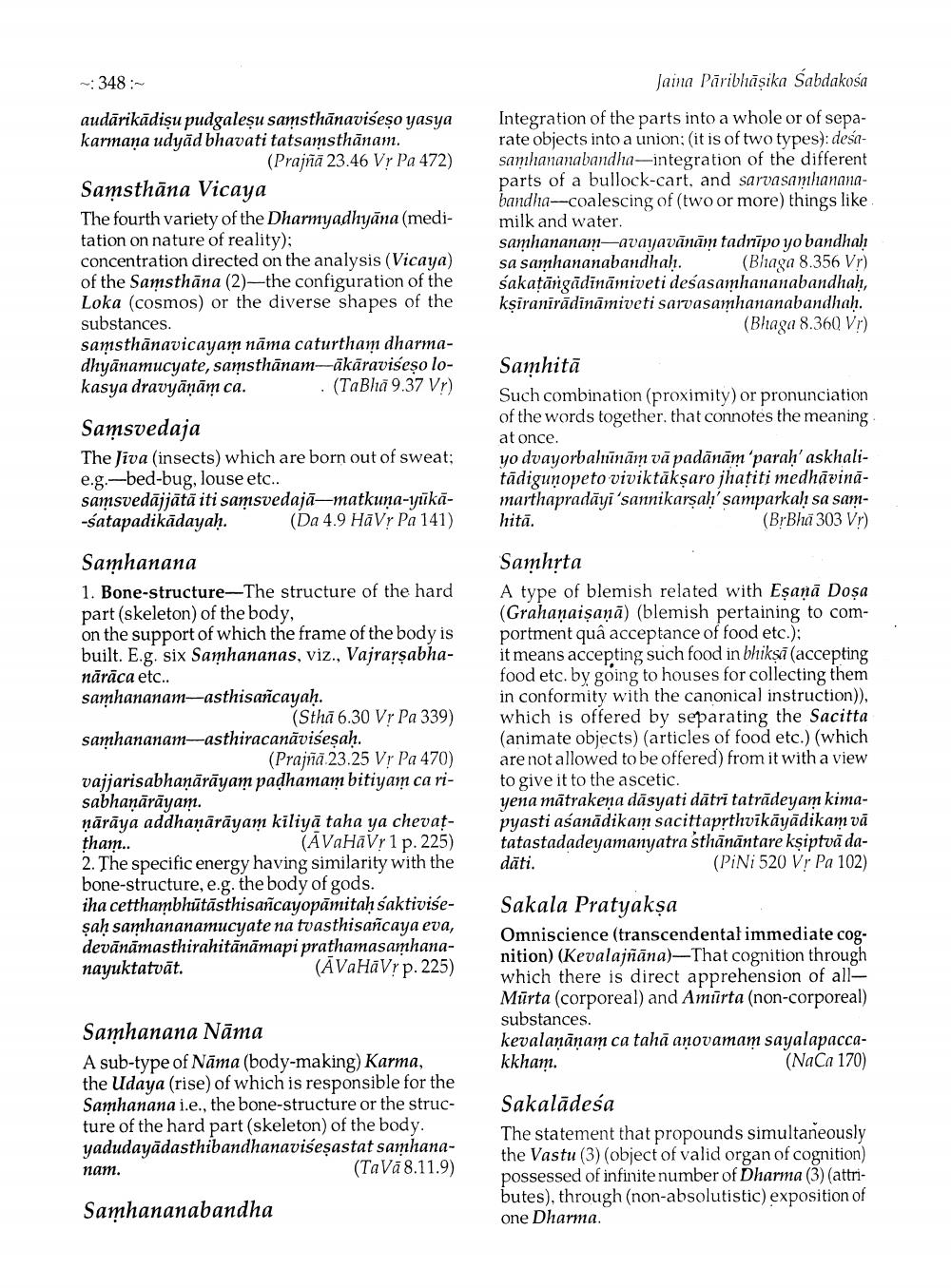________________
348:
audārikādişu pudgalesu samsthānaviseşo yasya karmaņa udyād bhavati tatsamsthānam.
(Prajñã 23.46 Vy Pa 472) Samsthāna Vicaya The fourth variety of the Dharmyadhyāna (meditation on nature of reality); concentration directed on the analysis (Vicaya) of the Samsthāna (2)—the configuration of the Loka (cosmos) or the diverse shapes of the substances. samsthānavicayam nāma caturtham dharmadhyānamucyate, samsthānam-äkāraviseso lokasya dravyāņām ca. . (TaBhā 9.37 Vr)
Jaina Pāribhāṣika Sabdakosa Integration of the parts into a whole or of separate objects into a union; (it is of two types): desasamhananabandha-integration of the different parts of a bullock-cart, and sarvasamhananabandha--coalescing of two or more) things like milk and water. samhananam-avayavānām tadripo yo bandhah sa samhananabandhah. (Bhaga 8.356 Vr) sakatāngādināmiveti desasamhananabandhah, kşiranīrādināmiveti sarvasamhananabandhah.
(Bhaga 8.360 Vr)
Samsvedaja The Jiva (insects) which are born out of sweat; e.g.-bed-bug, louse etc.. samsvedājjātā iti samsvedajā—matkuņa-yükā-satapadikādayah. (Da 4.9 HāVy Pa 141)
Samhita Such combination (proximity) or pronunciation of the words together, that connotes the meaning at once. yo dvayorbalīnām vā padānām 'parah' askhalitādigunopeto viviktākṣaro jhatiti medhāvināmarthapradāyi'sannikarşal' samparkaḥ sa samhitā.
(BrBhā 303 Vr)
Samhanana 1. Bone-structure-The structure of the hard part (skeleton) of the body, on the support of which the frame of the body is built. E.g. six Samhananas, viz., Vajrarṣabhanārāca etc.. samhananam-asthisancayah.
(Sthā 6.30 Vr Pa 339) samhananam-asthiracanāvisesaḥ.
(Prajna 23.25 Vr Pa 470) vajjarisabhaņārāyam padhamam bitiyam ca risabhaņārāyam. nārāya addhaņārāyam kiliyā taha ya chevattham.. .
(ĀVaHãVr1 p. 225) 2. The specific energy having similarity with the bone-structure, e.g. the body of gods. iha cetthambhūtāsthisañcayopāmitaḥ saktiviseşah samhananamucyate na tvasthisañcaya eva, devānāmasthirahitānāmapi prathamasamhananayuktatvāt.
(AVaHãVrp. 225)
Samhrta A type of blemish related with Eşaņā Doşa (Grahaņaişaņā) (blemish pertaining to comportment quâ acceptance of food etc.); it means accepting such food in bhikṣi (accepting food etc. by going to houses for collecting them in conformity with the canonical instruction)), which is offered by separating the Sacitta (animate objects) (articles of food etc.) (which are not allowed to be offered) from it with a view to give it to the ascetic. yena mātrakeņa dāsyati dātri tatrādeyam kimapyasti ašanādikam sacittaprthvikäyädikam vā tatastadadeyamanyatra sthānāntare kşiptvā dadāti.
(PiNi 520 V? Pa 102)
Sakala Pratyakşa Omniscience (transcendentat immediate cognition) (Kevalajñāna)-That cognition through which there is direct apprehension of allMūrta (corporeal) and Amūrta (non-corporeal) substances. kevalaņāņam ca tahā anovamam sayalapaccakkham.
(NaCa 170)
Samhanana Nāma A sub-type of Nāma (body-making) Karma, the Udaya (rise) of which is responsible for the Samhanana i.e., the bone-structure or the structure of the hard part(skeleton) of the body. yadudayädasthibandhanaviseşastat samhananam.
(Tavā 8.11.9)
Sakalādesa The statement that propounds simultaneously the Vastu (3) (object of valid organ of cognition) possessed of infinite number of Dharma (3) (attributes), through (non-absolutistic) exposition of one Dharma.
Samhananabandha




